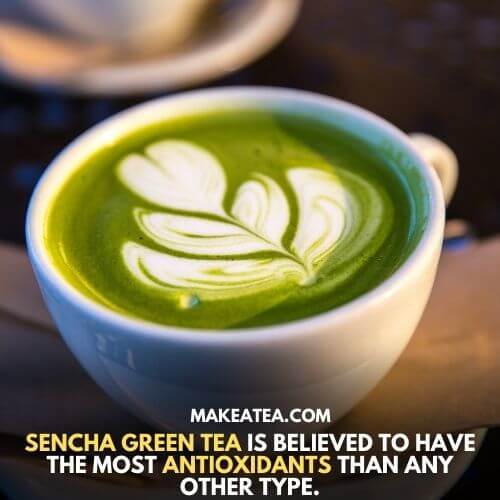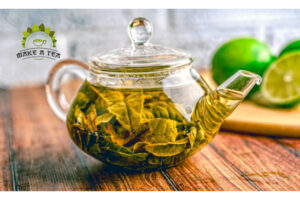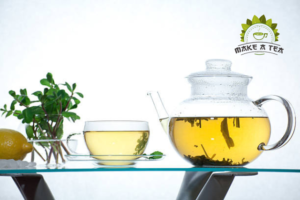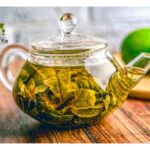You can run, you can hide but you can’t escape Sencha in Japan!
Just like its name, Sencha Green Tea is an exceptional Japanese green tea meaning ‘’simmered tea’’ in English. This refers to dried tea leaves.
While in most countries, Chinese Green Tea is mostly available and exported. But in Japan, Sencha Green Tea is widely used and most popular.
Sencha is 80% of all the teas produced in Japan. It is becoming more and more known and famous in other parts of the world a well, all because of its benefits and versatility.
What Is Japanese Sencha Green Tea?
Sencha is a green tea produced and consumed across Japan. This tea is also made from the Camellia Sinensis plant, which gives us all other teas like black tea, green tea, oolong tea, etc.
Sencha is a plain classic tea that is steamed and turns out to be green-gold color. Sencha represents Japanese culture. You may have seen in movies Japanese men with tiny little special cups sipping green tea.
You won’t see a home where Sencha is not brewed daily. Indeed, it is taken after meals, at restaurants, meetings. Thus, everywhere you go in Japan Sencha teas fragrance will follow you.
The History Behind Sencha Green Tea
Zen culture was added by the Japanese in their tea-making ways during Sung dynasty of old China.
In the 15 century, roasted green tea also called Kamairicha was invented by the Ming people.
During the 17th century, a Chinese Buddhist Priest Ingen came to Japan from China. He introduced many ways of making teas in Chinese culture. He was the one who founded the Obaku school of Zen Buddhism.
In the 18th century, sencha started to sell widely in Kyoto by Kouyugai and Shibayama gensho. They were against the places with stereotypes of expensive tea sets.

Thus ,they made a model by following masters of the Tang dynasty. These people had a gentle and down-to-earth style of tea which became popular and liked by Japanese people.
History also reveals thousands of years ago, some Japanese monks who studied Buddhism in China first introduced Green tea in Japan. It was a trademark of religious Japanese communities at first.
Finally, local public had access to it and it became common. But when the cultivation of tea started in Japan it got introduced to elite classes and later commonly spread to the local public for consumption.
Cultural Value of Sencha Green Tea In Japan:
Japanese people has this tea in every home and everybody loves it, its deeply rooted in their culture.
Sencha Green Tea in Everyday Life
Sencha is a symbol of hospitality in Japan. It is served to guests as well as incorporated into the daily life of a normal person in Japan. Restaurants offer free Sencha to customers as is an essential part of the diet.
According to a researcher in nutrition, at the Icahn School of Medicine at Mount Sinai Hospital, “It’s the healthiest thing I can think of to drink.”
Celebrating Sencha Green Tea Day
Green Tea day is celebrated in full swing in Japan. They celebrate the properties, benefits, and cultural value of green tea. It is celebrated on the 88th day of spring also called Risshun in Japan.
One may wonder why the 88th day?
Because on the 88th day the tea leaves are most fresh and green. Japanese people believe they bring good luck.
Thus, green tea day brings celebration and acknowledgment for this healthy drink.
Flavors of Sencha
The Japanese love Sencha! It’s in their blood and veins. The quality of Sencha depends upon different blends, types, and brands.
The taste varies upon the growing region, quality, and price. Hence, the sweet aroma welcomes you to the spring season and the flavor has a grassy taste.
Although, if you are tasting Sencha for the first time. It might taste funny to you. But it is a matter of time you get used to it. One thing people skip is drinking Sencha in summers.
However, It can also be cold-brewed. Taking sencha in the summers makes your body light and refreshing.
How Much Caffeine Is In Sencha Green Tea?
All teas contain caffeine. Although, younger and older leaves have different levels of caffeine. Also roasted and non-roasted caffeine levels may differ as well. Sencha green tea leaves have 20-30 mg of caffeine per cup.
This tea gives a lot of energy and freshness to the user. Although, you should avoid taking it right before bedtime.
7 Amazing Benefits Of Sencha Green Tea
Sencha green tea is believed to have the most antioxidants than any other type. It is because of its steamed process. The benefits include all the incredible benefits of green tea plus its own that are mentioned below:

1) Healthy Heart
Japanese people live up to hundred years. The secret to their long life is healthy heart. They make it stronger through out their life by drinking green tea. Sencha is great for making your hearth health better.
It prevents heart diseases by protecting against heart diseases. Study shows people who did not drink green tea were prone more to heart attacks than the people who had taken this tea.
2) Boost Immune System
Keeps your body healthy by preventing diseases and boosting your immune system.
3) Dental Health
Sencha not only refreshes your body but it also give freshness to your mouth and breath. It improves dental health by preventing tooth decay and keeps the mouth smelling fresh. It also helps keeps the bacteria’s away which cause decay and tooth damage.
4) Beautiful Skin
It regenerates cells and keeps your skin youthful and shiny. It is also anti-aging and faces away fine lines. Look t Japanese people their skin is shiny and smooth no matter what age group they belong. Now we know the secret behind.
5) Weight loss
All thanks to Sencha green tea, it is a natural and healthy way to lose that stubborn weight. It aids weight loss by burning fats and making the metabolism faster. Green tea is a commonly taken drink for the purpose of losing some pounds.
6) Cancer Prevention
Sencha Green tea is known to fight cancer cells. Thus, preventive for cancer treatment.
7) Anti-Allergy
It is most effective in allergy season. Due to the anti-inflammatory properties it also helps itching and burning caused due to the allergy. Also, green tea is anti-bacterial and helps with various allergies. It may also fight various viral infections.
Types of Sencha Tea:
Sencha is a basic Japanese drink, found and grown everywhere in Japan. It has a dark color and somewhat astringent flavor. What makes it different from other types of teas is the processing methods. These methods vary, which makes different types of Sencha teas.
Three Main Types Of Sencha Green Tea
These types are different based on steamed time while processing is going on.
- Fukamushi-cha 深蒸し (deep steamed)
- Asamushi 浅蒸し (lightly steamed)
- Chumash 中蒸し or Futsumushi-cha (medium steamed).
Comparison of Fukamushi-cha with Other Sub-Types:
| Type of Sencha Tea | Steaming Time | Leaf Shape | Fragrance | Tea Color | Taste |
| · Fukamushi-cha/ Fukamushi Ryokucha | 90-120 sec | Powder form & broken | Weak | Darkish green | Deep rich |
| · Asamushi | 20-30 sec | Uniformed & long | Strong | Clear light-green | Rich/ Astringency |
| · Chumushi/ Futsumushi-cha | 40-60 sec | Long, narrow and uniform | Fresh | Clear light-green | Rich/ Astringency |
All the Japanese green teas differ from Chinese ones because they are steamed. While the Chinese teas are pan-fried.
All above teas are the sub-types of Sencha, and there are others like Kabuse-cha (Covered Tea), Ichiban-cha (First Crop Tea), and Aracha (Crude Tea) but the main is Fukhamushi-cha or Fukamushi Ryokucha.
In this article, we will focus on this one.
Fukamushi-cha Sencha Green Tea
Fukamushi means steamed for a long time. This tea is steamed double the time of normal Sencha and is called Fukamushi Sencha or Fukamushi Ryokucha
Due to the most exposure to the steam, this becomes powdery, stronger in taste. The color also becomes a darker shade of green.
The Taste of Fukamushi Sencha Green Tea
This green tea is steamed for stoping the oxidation process. Due to steaming it 2 to 3 times longer than normal Sancha, it becomes rich deep taste. Most of the Japanese love this taste. The taste is not as bitter as normal sencha.
The secret behind the blended taste is the added rolling and drying process, during this, the small particles of leaves are broken and detached from leaves. These become part of tea. Hence the taste.
Why Does This Fukamushi Tea Go Through Deep-Steam Process?
- To make it finer and get higher leaf content.
- Similarly, steaming the tea leaf double the time makes the brew a darker color.
- In addition, to make active components absorbed in the body.
- Next, it makes the grassy and bitter taste of normal tea disappear.
- Hence, this process makes the fukamushi sencha powdery and with a stronger brew and taste.
Why Is Fukamushi-Sencha Common In Shizuoka-Cha And Kagoshima-Cha?
Do you know that finding Fukamushi-Sencha may be harder than normal sencha?
On the other hand, Fukamushi is quite abundant and common in a few areas.
Why is that? Because of the types of tea farms.
Types of Tea Farms
There are two types of categories.
Category 1 Tea Farms
These are located on the slopes of mountains. The most common of these areas are in Shizuoka. On the contrary, the farms are smaller in size. The automated plucking of leaves is harder, therefore it is produced in less quantity.
Category 2 Tea Farms
On the other hand, the tea leaves in these farms are on vast flat farmlands. These are suitable for mass production. The work can be done through machines. Hence tea leaves can be collected in more quantities.
The Fukamushi-Sencha is very common in the tea farms of this category. Due to the sunlight the tea leaves get a lot of heat. Therefore they become dry and hard.
Therefore, Fukamushi-Sencha is largely produced in areas such as Shizuoka and Kagoshima.
The Health Benefits Of Fukamushi Green Tea:
Fukamushi tea has all the health benefits of Sancha plus its own. So, let’s see what is this type of tea all about:
All Benefits of Sencha
Firstly, it includes all the benefits of sencha which we are discussed separately in this article.
Catechin
A type of polyphenol, catechins are full of antioxidant qualities. It regenerates the cells and makes you young and stronger. It also contributes to weight loss, cholesterol control, high BP, and tooth decay.
More Nutrients than Sencha Green Tea
This tea includes Vitamin E, Minerals like Zinc, Copper and Manganese, chlorophyll, and fiber which is best for maintaining intestinal health. Thus, all these nutrients are lost in normal Sencha while preserved in this type.
How to Brew Fukamushi Sencha Green Tea?
Instructions
Brewing time
The best time for brewing is about 30 seconds. In fact, as this type of tea is already steamed, its flavor comes quickly and more brewing is not needed.
Usage
You can either check instructions on the packaging or we recommend 4g of leaves to brew 120ml of tea for the perfect taste. Practice makes a man perfect.
Water Temperature and Infusion Time
The temperature should be anything between 70-90 degrees. It may also depend upon the low or high grade of tea leaf.
5 Possible Side Effects of Sencha Green Tea:
Although Sencha is perfectly safe to consume. There is ongoing research to find out the harmful side effects of Sencha. These may vary from person to person. As a preventive measure, we are mentioning possibilities after consuming Sencha Tea.
1) Tummy Troubles
Drinking it might effect digestive system of people who are sensitive. Drinking too much of this drink or taking it at the times which is not recommended specially if you are prone to have stomach troubles can cause this.
2) Palpitations
Secondly, after taking Sencha some individuals may face dizziness, nausea, and palpitations. This may be normal if happens once or twice but if this happens all the times with your ears ringing, you need to see a doctor.
3) Anxiety
Some individuals may face this issue. One of the side effects may be anxiety and sleeping disorders. If you face issues sleeping then avoid taking green tea for a while. Also taking it later at night is never recommended. It will make you go to the washroom all night long and may cause sleep disruptions and delay in sleep.
4) Reactions
Although rarely, but it can cause allergic reactions like swelling, breathing issues. If this happens, you may try to change the brand of your green tea. Also watch out if you are adding any ingredient like lemon or honey which might be the cause of the reaction.
5) Iron Deficiency
The compounds and anti-oxidants are great but they can interfere in the absorption of iron in the body. If you are an anemic person but still dont want to leave green tea, add more water to your diet and also you can start taking iron supplement by consulting your doctor.
Conclusion:
Sencha is a known and popular form of Japanese green tea. It makes 80% of the teas produced and consumed in Japan. It contains many nutrients like Vitamin C, Catechins, Folic Acid, Potassium, Caffeine and many more.
No doubt Japan is a major green tea-drinking nation. They live actively with beautiful skin with a life expectancy of 100 years. It’s the other nations also realize the health benefits and incorporate in their life to yield the benefits.








